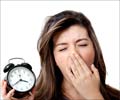About three-fourths of individuals with insomnia report experiencing the condition for at least one year and almost half experience it for three years, according to a report in the
About three-fourths of individuals with insomnia report experiencing the condition for at least one year and almost half experience it for three years, according to a report in the March 9 issue of Archives of Internal Medicine, one of the JAMA/Archives journals.
Insomnia is the inability to fall asleep or stay asleep. “Approximately 30 percent of adults report symptoms of insomnia and 6 percent to 10 percent meet diagnostic criteria for an insomnia disorder,” the authors write as background information in the article.Several factors such as being female, increasing age, having anxiety or depression and experiencing pain from medical conditions have been associated with insomnia. The condition has been linked to higher health care costs, work absenteeism, disability and higher risk of hypertension and depression.
Charles M. Morin, Ph.D., of Université Laval and Centre de recherche Université Laval - Robert Giffard, Québec, Canada, and colleagues evaluated insomnia persistence, remission and relapse in 388 adults (average age 44.8) over a course of three years.
Individuals with an insomnia syndrome (insomnia symptoms at least three nights per week for at least one month causing substantial distress or daytime impairment) at the beginning of the study (n=119) were compared to those with insomnia symptoms (n=269) to examine the course of initial severe sleep difficulties.
“Of the study sample, 74 percent reported insomnia for at least one year and 46 percent reported insomnia persisting over the entire three-year study,” the authors write. The group with initial insomnia syndrome had a higher persistence rate than the group with symptoms of insomnia (66.1 percent vs. 37.2 percent), respectively.
About fifty-four percent of participants went into insomnia remission; however, 26.7 percent of them eventually experienced relapse. “Individuals with subsyndromal insomnia [insomnia symptoms] at baseline were three times more likely to remit than worsen to syndrome status, although persistence was the most frequent course in that group as well,” the authors note.
Advertisement
Results were similar after the second and third year of follow-up. Of the 119 participants with insomnia syndrome at the beginning of the study, 17 percent were good sleepers after one year, while 37 percent had symptoms of insomnia and 46 percent remained in the insomnia syndrome group.
Advertisement
“Improved understanding of the long-term course of persistent insomnia would be helpful to guide the development of effective public health prevention and intervention programs to avert long-term negative outcomes.”
Source-Newswise
SRM















